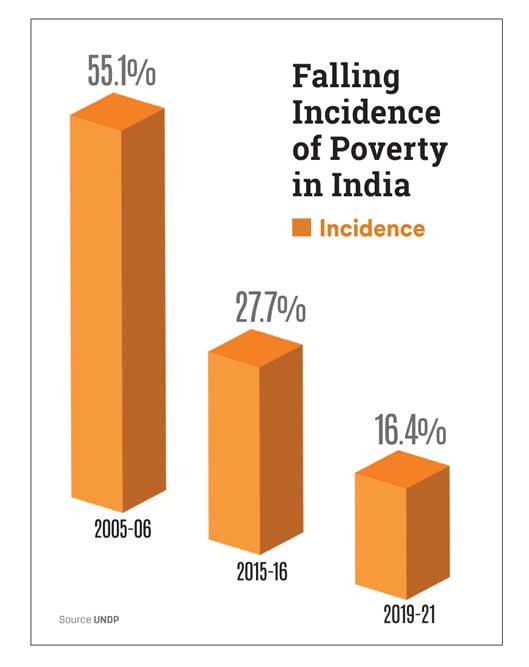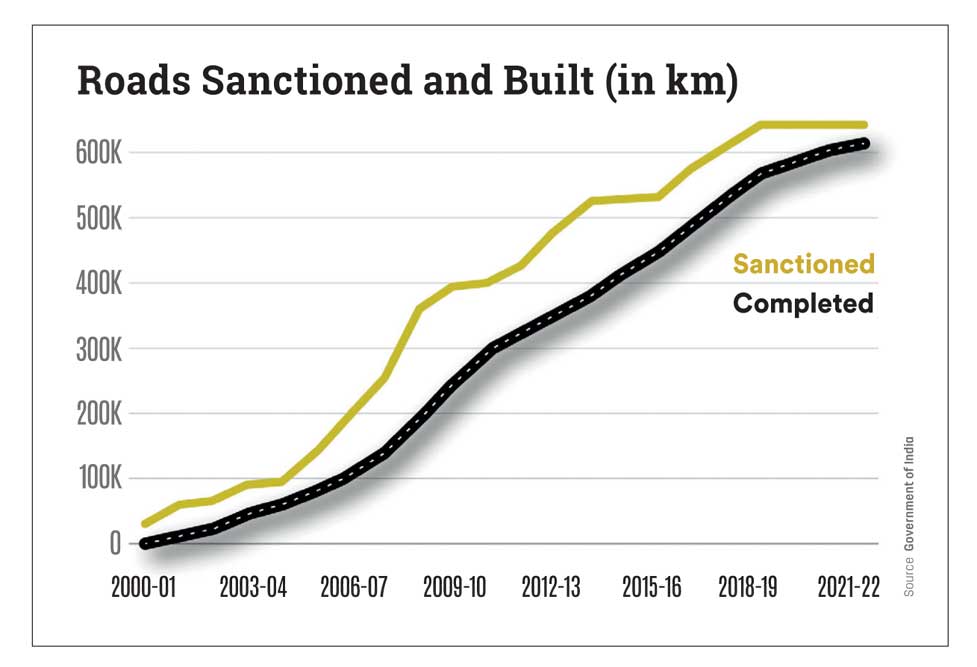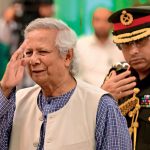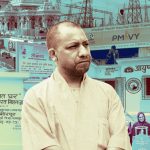Why Modinomics Works
Empowerment enabled by excellent last-mile delivery and digital public infrastructure has resulted in NDA’s all-round economic success
 Anil Padmanabhan
Anil Padmanabhan
 Anil Padmanabhan
Anil Padmanabhan
 |
29 May, 2024
|
29 May, 2024
/wp-content/uploads/2024/05/ModiOptics.jpg)
(Illustration: Saurabh Singh)
ADDRESSING A MASSIVE election rally in Bansgaon, Uttar Pradesh (UP), on the eve of the seventh and final phase of the ongoing General Election campaign, Prime Minister Narendra Modi took an impromptu masterclass on economics and political communication. In his inimitable style, Modi unpacked the importance of growing the Indian economy for the common person.
He began by drawing up a listicle of the ongoing and completed infrastructure projects in the state and pointed out that this was rewriting the profile of UP—till recently considered among the laggard states in the country.
“In UP everyone now says with pride that they belong to the state. There is a reason for this. In comparison to other states, UP is not just performing well, in some metrics, it is doing even better,” he told a cheering audience.
And then he went on to remind the audience that he too was elected to Parliament from the state and as an MP from Varanasi. As a result, he was very much part of Purvanchal or eastern UP and their neighbour.
“My UP,” the prime minister said thumping his chest, “Now has the distinction of being the state with the maximum number of airports; my UP is the state with the largest number of expressways; my UP is developing the largest Metro rail network in the country. People of Bansgaon, Deoria and Gorakhpur are therefore witness to the profound transformation that is underway.”
Extolling the performance of the state and Union governments or what he described as the “double-engine sarkar”, the prime minister then went on to cite key infrastructure projects bringing unprecedented mobility to the region.
This included the Purvanchal Expressway, the 340km access-controlled six-lane highway connecting Ghazipur, located on the state’s border with Bihar, to Lucknow, the state capital, the 90km Gorakhpur Link Expressway which will reduce travel time to Lucknow by two hours, the four-lane Ram Janki Marg connecting the religious sites of Sitamarhi in Bihar to Ayodhya in UP, the location of two airports in Kushinagar and Gorakhpur within the vicinity of Bansgaon and the improved access to healthcare with the setting up of the All India Institute of Medical Sciences (AIIMS) in Gorakhpur.
Modi argued that all these projects are examples of how a growing Indian economy improves ease of living for the average citizen.
“The list of achievements is much longer. We pulled this [incredible feat] off in just 10 years,” he said and paused for effect. To loud cheering, he added, “And, even then I say that this is just a trailer.”
“If the trailer is so impressive, you can assess for yourselves as to how the next five years will transform UP’s and India’s future. So, every vote you cast for BJP will accrue to me and contribute to realising the country’s prosperous future,” the prime minister added.
Implicitly signalling that his government would be re-elected for a record third term, Modi said that another three-crore people were keenly awaiting the results on June 4 to queue up for their housing—the Union government has already handed out four crore homes to the poor.
Similarly, crores of youth are waiting for the declaration of the outcome so that they can access ₹20 lakh MUDRA loans to set up their own businesses. Thanks to the spread of self-help groups (SHGs), another three crore women are waiting for June 4 to avail of the ‘Lakhpati Didi’ scheme. All of these are commitments made in the Bharatiya Janata Party’s (BJP) election manifesto.
Summing up his masterclass, the prime minister said, “The countdown for India becoming the third-largest economy in the world has begun. When this happens, every Indian will have a better chance to prosper and benefit.”
Fragile Five to Top Five
A singular claim of the BJP-led National Democratic Alliance (NDA) is that in their decade-long rule they have delivered the Indian economy, despite unprecedented back-to-back economic shocks beginning with the Covid-19 pandemic, which had dodgy origins in Wuhan, China, from the “fragile five” to the top five in the world.
To realise this, NDA undertook an ideological pivot, one which emphasised empowerment over entitlement—the calling card of their predecessor, the Congress-led United Progressive Alliance (UPA). While NDA laid emphasis on teaching people how to fish, UPA preferred handing them the fish.
Broadly, UPA pursued a demand-side economic strategy, which entailed creating demand by providing income in the hands of the consumer, including payouts through subsidies and their marquee rural employment guarantee scheme.
In contrast, NDA’s economic ideology leaned on a supply-side approach, which entailed reducing taxes on businesses and individuals (still a promise), deregulation, ramping up investment in education and infrastructure. Essentially, providing an ecosystem that would foster investment and economic growth.
Given the nature of Indian democracy with the prime minister being the first among equals, the economic strategy is defined by the leadership of the Union government. This is because in India any economic change must pass the smell test conducted by the prime minister. Yes, the authorship is always that of the finance minister, but it is owned by the prime minister. Seen through this lens, there are four defining eras.
The first one was Nehrunomics. This was the period when an India, after escaping the clutches of colonial rule, was looking to build the economy from scratch. The fundamental ideology then was that the commanding heights of the economy would be occupied by the public sector. However, the contradictions of this command-control regime, drawn from the planning model pursued by the erstwhile Soviet Union, began to catch up.
But for a cruel turn of fate, India may have said goodbye to this regime under the brief leadership of Lal Bahadur Shastri. Shastri was pragmatic and leaned towards market forces; or at the least did not want to put all his eggs in the public sector basket.
His abrupt death and the entry of Indira Gandhi on the stage forced another rejig. There were two phases of Indiranomics. One in which she pursued populism in the 1970s to mitigate the ill effects of Nehrunomics.
The second phase was after she reclaimed power in 1980. By then she had realised that denying market forces their play was severely damaging the economy. But her pivot had to be subtle as her politics was perceived to be strongly pro-poor and anti-business.

Exactly how the term ‘reforms by stealth’ took root. But let the truth be told. The blueprint for the big push for reforms which happened 11 years later was hatched in the Sixth Five Year Plan penned by Gandhi’s regime.
The third phase is of course Raonomics. While the bulk of the credit for the 1991 reforms goes to then-Finance Minister Manmohan Singh (deservedly so), the real architect was Rao. The big move on de-licensing of industries was piloted by the industry ministry, which was under Rao’s direct charge.
Also, the fine-tuning of the package started in the short tenure of Prime Minister Chandra Shekhar. The common thread was Amar Nath Verma, the powerful bureaucrat who worked with the administrations headed by VP Singh, Chandra Shekhar and Rao. It was Verma who ensured the blueprint, in the making for several years in the government’s backroom, was brought to the notice of Rao.
To its credit, over the last decade, NDA has pursued its outcome-oriented welfare programmes to a plan and on mission mode. And this is where NDA has differed from past regimes: The gap between promise and delivery is minimal. The DPI architecture has enabled NDA to undertake public good at a staggering scale
Now we add Modinomics with its guiding ideology of empowerment to this mix. Its biggest attribute has been the boldness and willingness of Modi to use his hard-earned social capital in pushing, on the face of things, unpopular reforms—including, the aborted land reforms and farm laws, demonetisation, privatisation of public sector undertakings (PSUs) and formalisation of the Indian economy through the implementation of the Goods and Services Tax (GST). To the prime minister’s credit, he has had the courage and conviction to walk the talk on fundamental change—something that has been debated in Lutyens’ Delhi from the 1980s but rarely has any regime had the courage to follow through on it.
Escape from Poverty
To its credit, over the last decade, NDA has pursued its outcome-oriented welfare programmes to a plan and on mission mode. And this is where NDA has differed from past regimes: the gap between promise and delivery is minimal.
First, it ensured targeting of welfare spending by triangulating the beneficiary, using the trinity of Jan Dhan-Aadhaar-Mobile (JAM) of an individual—cumulatively this saved ₹3 lakh crore in leakages to the exchequer and worked as a lifeline during the pandemic.
Second, it drew up a blueprint to universalise these benefits. To make this possible, NDA weaponised Aadhaar—the 12-digit unique identity it inherited from UPA.
So, NDA provided Aadhaar legal cover—a glaring error of omission on the part of UPA which had led to the national identity project facing a serious legal challenge—by enacting a law. It then passed a privacy law to protect the data of users.
Thereafter, it worked with technology evangelists to spawn India’s unique digital public infrastructure (DPI) by making Aadhaar its foundation.
This DPI architecture has enabled NDA to undertake public good at a staggering scale, something that has caught global attention. In fact, the G20 summit in Delhi last September adopted this as the global standard.
For instance, using DPI India banked 51 crore people—more than the population of the US—in the last decade. According to the Bank for International Settlements (BIS), the bank for central
banks across the world, this is an enviable record. In the normal course, BIS said, this would have taken a country 47 years to achieve.
Simultaneously, there has been a massive rollout of physical infrastructure, especially rural roads and national highways. The growth has been astounding in the last decade.
As the prime minister pointed out at his rally in Bansgaon, development of national highways more than doubled to 9,304km in 2023. Similarly, the rural roads project, since its launch in 2000, had completed 3.81 lakh km till 2014; over the next decade, this grew by 7.23 lakh km.
This convergence of digital, physical, and social infrastructure has transformed India into a Phygital Nation, creating the basis for steadily bridging the gap in ease of living. Where earlier access to basics like toilets, cooking gas, banking, electricity, telephones and so on was considered a privilege, today this is getting universalised.

The National Family Health Survey-5 (NFHS-5) confirms the surge in the use of cooking gas, toilets, access to electricity and ownership of bank accounts and homes by women.
The All India Debt and Investment Survey conducted in 2019 corroborated the financial inclusion trends captured by NFHS-5. It found that nearly three in four Indians, living in rural or urban areas, now own a bank account—in 2010, 430 million people did not own a bank account.
Access to basics has had a dramatic impact on poverty alleviation. The 2022 report on global poverty from the United Nations Development Programme (UNDP) revealed that India successfully lifted 415 million out of poverty in the 16 years ending 2021.
The convergence of digital, physical, and social infrastructure has transformed India into a phygital nation, creating the basis for steadily bridging the gap in ease of living. Where earlier access to basics like toilets, cooking gas, banking, electricity, telephones and so on was considered a privilege, today this is getting universalised
In other words, even a decade ago, about 500 million Indians— more than the population of the US—were outside looking in. Today, it is the other way round. The nature and scale of this socioeconomic makeover has the potential to be a force multiplier, rewriting the rules of engagement in India’s polity.
Governance Dharma
As Modi has often emphasised through this year’s election campaign and media interviews, NDA has excelled in its last-mile delivery. This success has not been enabled through any largescale reworking of either government or bureaucracy. I would say it is inspired by the management principle KISS—Keep it Simple, Stupid.
Take, for example, NDA’s first big idea of providing toilets in every home—announced by Modi in his first address to the nation on Independence Day from the ramparts of the Red Fort in 2014—under the Swachh Bharat Mission.
At that time, it was met with derision and dismissed. With the benefit of hindsight, it turned out to be a game-changer. Not just in securing hygiene at the level of a household and thereby improving the health of millions at the bottom of the pyramid—an estimated 600 million Indians used to defecate in the open—but also because it restored dignity, especially to women.
While the idea may be simple, NDA followed through with implementation by enabling real-time monitoring on a dashboard that could be accessed by the public too. To do so, the government reworked the processes—the prime minister revealed that over time the government slashed the time for preparing Cabinet notes; from several months, it is now prepared in less than a month.
Recently, Finance Minister Nirmala Sitharaman, a member of the Union Cabinet for the last decade, offered an inside view of how this makeover was managed.
Delivering the keynote address at the launch of a book—The Art of Implementation: How Modi ki Guarantee is Delivered—the finance minister said, “In 2014, the prime minister told us to look at all those pending projects; whether they are pending for decades, years, or for just one or two years. Look at all of them. Be sure to complete them. And till then not to even come up with anything new.”
Implicitly endorsing the KISS principle, Sitharaman summed up NDA’s governance dharma as follows:
◗ Complete all pending infrastructure projects, irrespective of when they were announced and by which political regime;
◗ Achieve saturation access to basic amenities like electricity, even in remote areas within every state;
◗ Monthly review of the progress of aspirational districts through video conferences with district collectors;
◗ Periodically review implementation of key schemes like Swachh Bharat Mission and analyse collateral gains through independent studies;
◗ Increase capital expenditure as a proportion of total expenditure to focus on asset creation and generate growth.
It is remarkably like what Deng Xiaoping, the man credited for China’s compelling success, famously said, “It doesn’t matter whether a cat is black or white, as long as it catches mice.”
The clear success of NDA is based on its ability to walk the talk of all governments post-Independence. And from all accounts, it has done so through diligence and application. On June 4, we will know whether the people of India concur with this surmise and reward them for their grunt work.

/wp-content/uploads/2025/01/Cover_Kumbh.jpg)












More Columns
What does the launch of a new political party with radical background mean for Punjab? Rahul Pandita
5 Proven Tips To Manage Pre-Diabetes Naturally Dr. Kriti Soni
Keeping Bangladesh at Bay Siddharth Singh